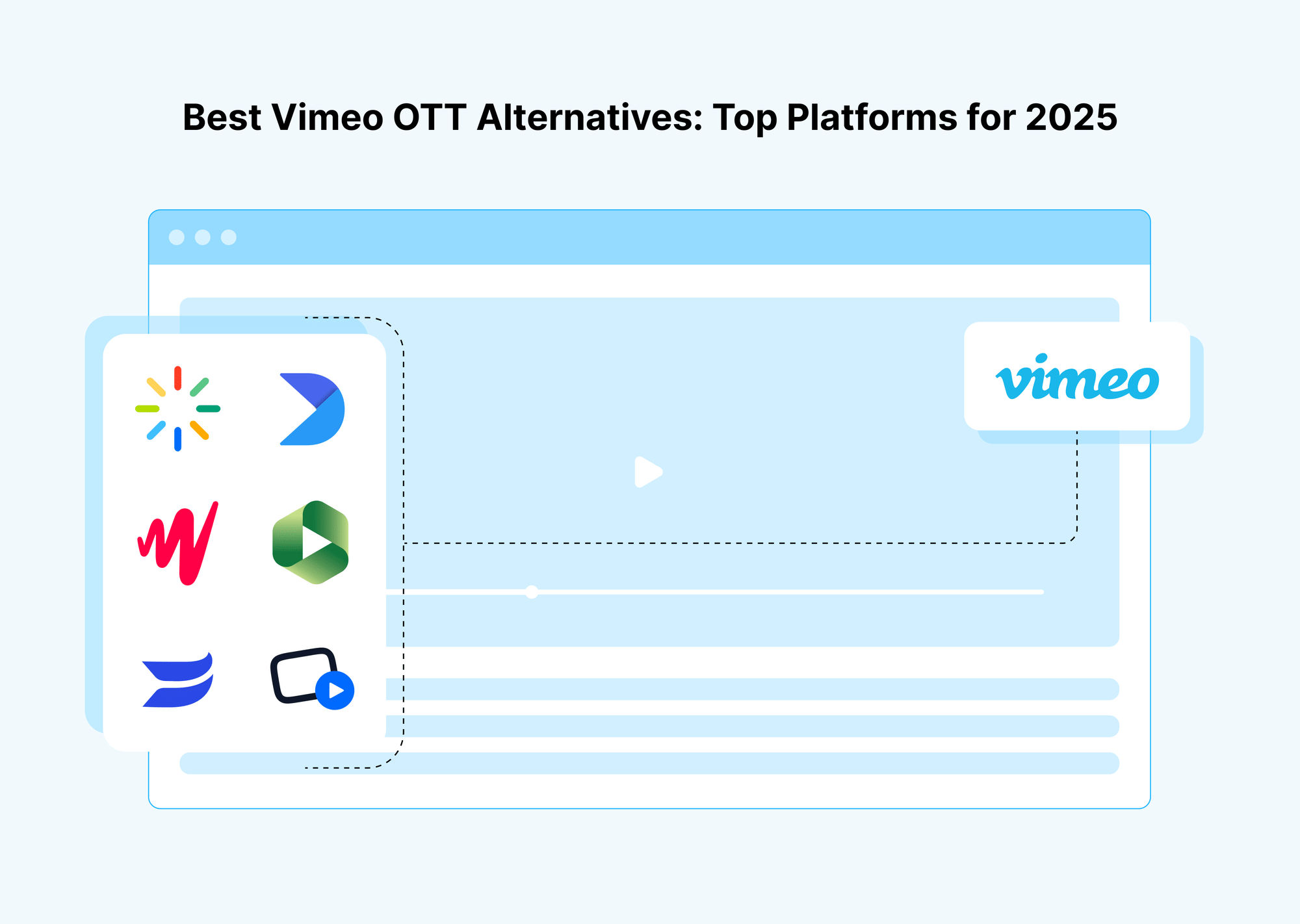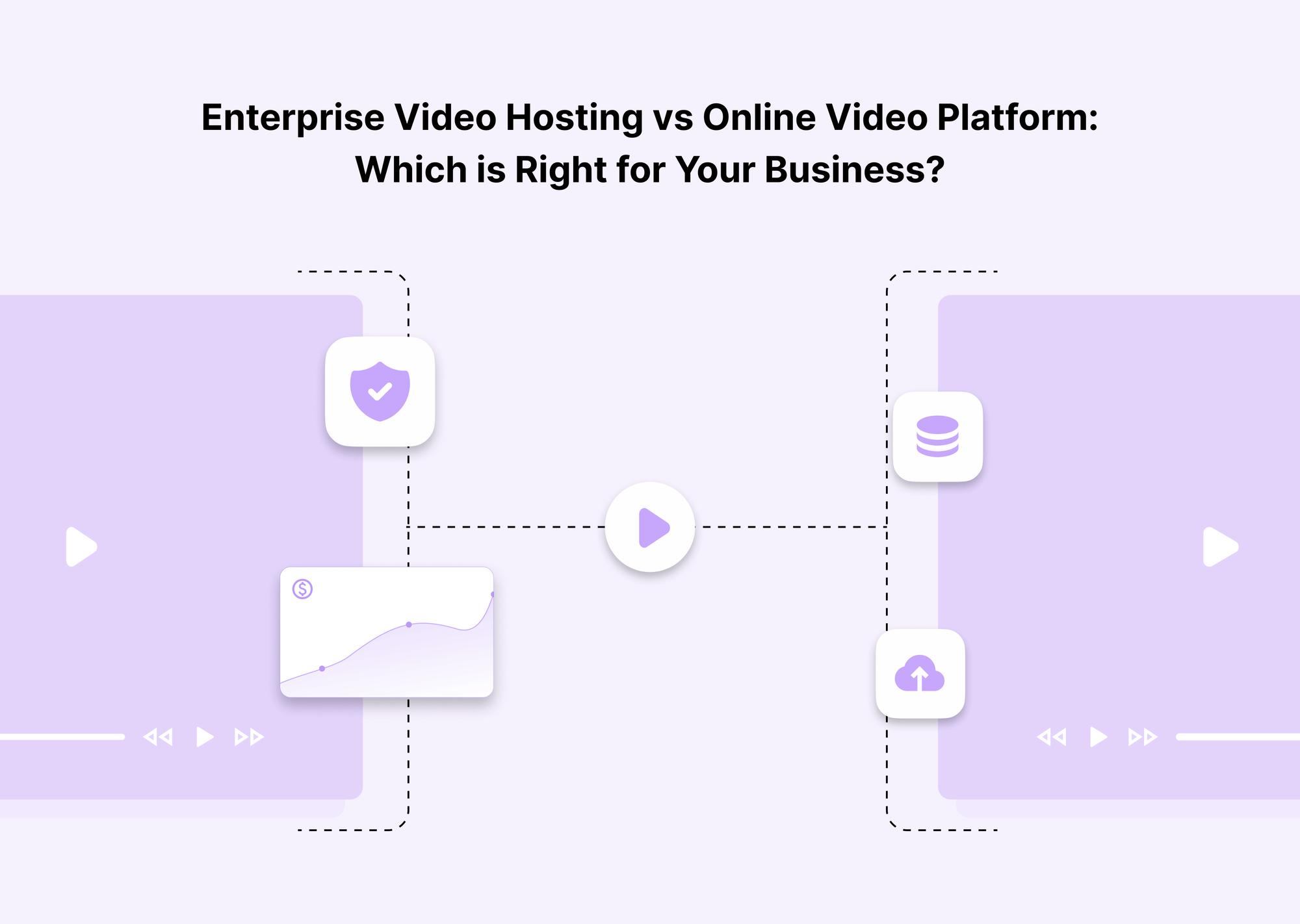Introduction
If you're looking for the best Vimeo OTT alternatives in 2025, you’re far from alone. A growing number of content creators, educators, fitness trainers, and broadcasters are moving away from Vimeo OTT due to rising subscription costs, limited customization, and restrictive monetization options.
The global OTT market is expected to grow from approximately USD 271.7 billion in 2025 to over USD 510 billion by 2030, reflecting a compound annual growth rate (CAGR) of 13.4% (Source: Uscreen.tv). This rapid expansion signals both rising demand and shifting expectations, prompting many businesses to reevaluate their streaming platforms.
In this guide, we’ll break down the top Vimeo OTT competitors, including Gumlet, Uscreen, Muvi, VPlayed, and Brightcove, with:
- Side-by-side pricing & feature comparisons
- Real-world migration tips to avoid subscriber churn
- Niche-specific recommendations based on your content model
Whether you’re:
- A fitness streamer monetizing workout sessions
- An edtech platform delivering interactive learning
- An independent filmmaker releasing premium content
- Or a global broadcaster scaling live events worldwide
…you’ll find actionable, scenario-based advice to help you choose the right platform, maintain brand control, and scale without hitting cost or feature ceilings.
By the end, you’ll know precisely which Vimeo OTT alternative aligns with your audience, monetization strategy, and growth plans, plus how to migrate without losing a single subscriber.
Why and When to Look for a Vimeo OTT Alternative?
Not every streaming business should stick with Vimeo OTT. In 2025, pricing changes, customization limits, and monetization gaps are pushing many creators and enterprises to seek better options.
Here’s when you should consider moving:
- Your costs are scaling faster than your revenue: Vimeo OTT pricing can spike with storage, bandwidth, and audience size, especially for growing channels. Example: A fitness streaming platform with 15k subscribers can see annual costs rise 30–40% vs competitors like Uscreen or Muvi.
- You’ve outgrown the customization limits: If your brand requires a fully white-labeled player, custom domains, or unique UI elements, Vimeo OTT’s restrictions may limit your user experience.
- You need more monetization flexibility: Hybrid models like SVOD + AVOD or tiered memberships are easier to set up (and track) on platforms like Gumlet or VPlayed.
- You require global scalability: Extensive catalogs, high-concurrency live events, or multi-region DRM can stretch Vimeo OTT’s capabilities.
- You want faster onboarding and support: Alternatives often provide dedicated migration teams to ensure no subscriber loss during platform transitions.
What to Look For in a Vimeo OTT Competitor
Not all Vimeo OTT alternatives are built the same. Before you migrate, create a checklist of the features and capabilities your streaming business can’t compromise on. Here’s what to evaluate and how top competitors stack up.
- Monetization Options: If you only run subscriptions (SVOD), you might be fine with basic tools. But if you need tiered memberships, pay-per-view (TVOD), or ad-supported streaming (AVOD), choose a platform that supports all three in one dashboard. Example: Muvi offers native hybrid monetization, while Uscreen is strong in SVOD and pay-per-view.
- Branding & Customization: White-labeling isn’t optional if you’re building a premium OTT brand. Look for custom domains, fully brandable HTML5 players, and UX control down to button colors and menu structure. Example: Gumlet supports brand overlays and AI-powered subtitles for accessibility.
- Device & App Support: Match your platform’s reach to your audience’s viewing habits, web, mobile (iOS/Android), and connected TVs (Roku, Apple TV, Fire TV, Smart TVs). Tip: Platforms like VPlayed specialize in enterprise-grade multi-device deployment.
- Video Security & DRM: If you offer premium or exclusive content, insist on Widevine/FairPlay DRM, watermarking, domain restrictions, and tokenized playback URLs. Example: Brightcove and Gumlet both offer enterprise-grade DRM with dynamic watermarking.
- Analytics & User Management: Don’t just count views; track engagement heatmaps, churn risk, and device-level analytics to optimize retention. Example: Uscreen integrates community engagement metrics into its analytics.
- Scalability: Your platform should be able to handle content library growth, subscriber surges, and high-concurrency live events without quality drops. Tip: Test with free trials or demos before committing.
- Pricing Flexibility: Avoid platforms with pricing that penalizes your growth. Look for transparent bandwidth/storage costs and discounts for annual plans.
Best Vimeo OTT Alternatives for 2025
1.Gumlet
Gumlet is one of the alternatives to Vimeo OTT, best known for its high-performance streaming with transparent, scalable pricing and advanced security features.
Pricing
- Free plan available. Paid plans start around $10/month (Starter), with Growth at $40/month and Business at $199/month. Includes overage rates for excess bandwidth/storage.
Key Features
- Transparent, tiered pricing with pay‑as‑you‑go overage rates.
- Enterprise-grade video protection: Widevine & FairPlay DRM, dynamic watermarking, signed URLs, domain and geo restrictions.
- Real-time analytics & AI-led delivery: Live viewer heatmaps, fast CDN delivery, AI-powered subtitles in 140+ languages.
- White-label player customization: Branding with custom domains, logos, CTA; you control the look and feel.
- Seamless integrations with Zoom, Zapier, S3, Google Drive, etc., plus strong API support.
Where Gumlet outshines Vimeo OTT
- Offers a free tier and significantly lower entry cost vs Vimeo’s $1 per subscriber + percent-of-purchase model.
- Real-time CDN performance and analytics go beyond Vimeo’s traditional analytics cadence.
- Security depth (DRM, dynamic watermarking) is more robust than Vimeo’s baseline offerings, making it one of the most secure video hosting platforms out there.
- Flexible monetization/integration makes it ideal for small teams scaling internationally.
Pros / Cons
| Pros | Cons |
|---|---|
| Extremely transparent, low entry pricing | Brand recognition still growing |
| Advanced DRM and security features | API and integrations may require some technical setup |
| Powerful real-time analytics and fast streaming globally | Free plan has limited storage/bandwidth |
| Customizable, white-label player | Less out-of-the-box marketing tools than Vimeo |
Gumlet vs Vimeo OTT: Gumlet offers more affordable, developer-friendly, and security-focused streaming, along with better customization and real-time analytics, making it especially suited for creators scaling quickly.
2.Uscreen
Uscreen is a leading alternative to Vimeo OTT, best known for its all-in-one monetization-first platform that empowers creators to launch branded membership services with ease.
Pricing
- Plans start at $199/month (Growth), $499/month (App Essentials), and custom pricing for enterprise-scale deployments.
Key Features
- Built‑in monetization models: Supports SVOD, TVOD, live streaming—with seamless checkout built via Stripe/PayPal.
- White-label mobile & TV apps: Launch your own iOS, Android, Roku, Apple TV apps; no coding required.
- Community and engagement tools: Forums, video challenges, and tiered subscriptions that help deepen viewer loyalty.
- Creator-first support & migration: Hands-on migration help for those leaving Vimeo, with 24/7 in-house support.
- All-in-one platform: Combines video hosting, marketing tools, analytics, and payment, all under one roof.
Where Uscreen outshines Vimeo OTT
- Supports all key monetization models while offering a fully integrated checkout experience; Vimeo lacks ad monetization.
- Offers native branded apps. Vimeo supports more device platforms overall, but Uscreen makes it easier to get your apps live quickly.
- Built-in community features give Uscreen an edge in engagement vs Vimeo’s more limited forum capabilities.
- Real creators report revenue increases (up to 409%) after migrating, thanks to Uscreen’s retention tools.
Pros / Cons
| Pros | Cons |
|---|---|
| All-in-one platform for monetization, apps, and community | Pricing may be high for smaller creators |
| Strong migration and creator support | Less granular device support than Vimeo (e.g., LG, Vizio) |
| Fast app launch with no-code needed | Limited advanced customization of player/UI |
| Built-in community tools that boost retention | No built-in ad (AVOD) monetization support |
Uscreen vs Vimeo OTT: Uscreen offers a more creator-friendly, app-first platform with superior monetization and community tools, while Vimeo provides broader device platform support.
3.Muvi
Muvi is a leading alternative to Vimeo OTT, best known for its fully managed, end-to-end OTT solution with extensive global streaming capabilities.
Pricing
- Plans start at $399/month (Standard), with Professional, Enterprise, and Ultimate tiers available. Custom pricing for large-scale projects. (muvi.com)
Key Features
- All monetization models supported: SVOD, TVOD, AVOD, donations, coupon codes, and hybrid setups.
- Global delivery network: Multi-CDN architecture for worldwide streaming without buffering.
- Custom mobile & TV apps: Branded iOS, Android, Roku, Fire TV, Apple TV, Samsung TV, LG TV apps.
- Robust DRM & security: Widevine, FairPlay, PlayReady, plus dynamic watermarking and geo-blocking.
- Integration flexibility: APIs, SDKs, and plug-ins for LMS, CMS, and CRM systems.
Where Muvi outshines Vimeo OTT
- More monetization models (including AVOD with ads) vs Vimeo’s focus on SVOD/TVOD.
- Broader device/app support, including LG and Samsung TVs.
- Higher scalability for global audiences and multi-language libraries.
- A fully managed setup means less technical overhead.
Pros / Cons
| Pros | Cons |
|---|---|
| Supports all monetization models | Higher entry cost than some competitors |
| Full white-label branding & extensive app coverage | May be overkill for small projects |
| Enterprise-grade DRM & CDN performance | Interface can feel complex for new users |
| Highly customizable with API/SDKs | Longer onboarding time compared to Vimeo |
Muvi vs Vimeo OTT: Muvi offers a more complete, globally scalable OTT package with AVOD support and broader app/device coverage than Vimeo OTT.
4.VPlayed
VPlayed is a leading alternative to Vimeo OTT, best known for deep customization and flexible monetization for broadcasters and enterprises.
Pricing
- Custom quote only, based on features, deployment, and scale. (vplayed.com)
Key Features
- Custom monetization models: Beyond standard SVOD/TVOD, support rentals, pay-per-session, and sponsorships.
- Omni-device deployment: Web, iOS, Android, Roku, Fire TV, Apple TV, Smart TVs.
- High-grade content protection: DRM (Widevine, FairPlay), AES encryption, watermarking, and IP restrictions.
- Complete brand control: 100% white-label design with custom UX flows.
- Advanced analytics: Real-time viewership metrics, ad performance tracking, and churn insights.
Where VPlayed outshines Vimeo OTT
- Custom monetization beyond the typical models offered by Vimeo.
- Greater control over UX for enterprises wanting a tailored viewer journey.
- Stronger security stack for premium broadcasters.
- Ideal for private deployments where Vimeo’s SaaS model may not fit.
Pros / Cons
| Pros | Cons |
|---|---|
| Highly customizable monetization & branding | No fixed pricing; higher cost for small teams |
| Enterprise-grade DRM & encryption | Steeper technical requirements |
| Real-time, advanced analytics | Lacks a self-serve free trial |
| Broad device & OTT app coverage | Pricing transparency could be improved |
VPlayed vs Vimeo OTT: VPlayed offers deeper customization, flexible monetization, and advanced security, surpassing Vimeo OTT’s more standardized approach.
5.Brightcove
Brightcove is a leading alternative to Vimeo OTT, best known for enterprise-level OTT delivery, robust integrations, and marketing tools.
Pricing
- Custom pricing based on bandwidth, storage, and feature set. Enterprise-focused packages. (brightcove.com)
Key Features
- Comprehensive monetization options — SVOD, TVOD, AVOD, sponsorships, and live event pay-per-view.
- Enterprise integrations — Connects with CRMs, marketing automation, and analytics platforms like Salesforce, Marketo, HubSpot.
- Global CDN delivery — Reliable, scalable infrastructure for millions of concurrent viewers.
- Advanced marketing tools — Video SEO, lead capture forms, audience segmentation, and retargeting support.
- High-level analytics — Engagement heatmaps, conversion tracking, and campaign attribution.
Where Brightcove outshines Vimeo OTT
- Stronger enterprise marketing stack for campaigns and lead nurturing.
- Deeper CRM/automation integrations that Vimeo lacks.
- Proven scalability for major live events and sports streaming.
- Ideal for organizations with complex multi-channel marketing needs.
Pros / Cons
| Pros | Cons |
|---|---|
| Powerful enterprise integrations & marketing tools | Higher cost, enterprise focus |
| Supports all monetization models including AVOD | Complexity may be unnecessary for smaller creators |
| Global CDN scalability for huge audiences | No low-cost entry plan |
| Advanced analytics with business intelligence focus | Requires onboarding for full potential |
Brightcove vs Vimeo OTT: Brightcove offers enterprise-grade integrations, scalability, and marketing capabilities well beyond Vimeo OTT’s core streaming features.
Comparison Table: Vimeo OTT Alternatives
Before choosing a Vimeo OTT alternative, it’s essential to compare pricing, monetization flexibility, device support, and security side-by-side. The table below breaks down the top contenders (Gumlet, Uscreen, Muvi, VPlayed, and Brightcove), showing exactly where each one outperforms Vimeo OTT.
| Platform | Pricing* | Monetization Models | Device/App Support | Security & DRM | Branding & Customization | Analytics Depth | Best For | Beats Vimeo OTT In… |
|---|---|---|---|---|---|---|---|---|
| Gumlet | From $10/mo + usage | SVOD, TVOD, AVOD, Live | Web, iOS, Android, Smart TV | Widevine/FairPlay, Watermarks, Signed URLs | Full white-label player, CTA overlays | Advanced real-time, heatmaps | Edtech, global streaming | API access, DRM depth |
| Uscreen | From $199/mo | SVOD, TVOD, Live | Web, iOS, Android, Roku, Apple TV | Password/domain control | White-label apps | Engagement + community metrics | Fitness, course creators | Community tools, app launch speed |
| Muvi | From $399/mo | SVOD, TVOD, AVOD, Live | Web, Mobile, Smart TVs | DRM, Watermarking | Full customization | Advanced | Enterprises, large catalogs | Global reach, monetization variety |
| VPlayed | Custom quote | Custom models | Web, Mobile, Smart TVs | DRM, Encryption | Full customization | Advanced | Broadcasters, media houses | Custom monetization, TV deployment |
| Brightcove | Custom quote | SVOD, TVOD, AVOD, Live | Web, Mobile, Smart TVs | DRM, Encryption | Custom branding | Enterprise analytics | Large organizations | Marketing integrations, API ecosystem |
Key Takeaways
- Best all-rounder: Gumlet; strongest for customization, DRM, and developer flexibility.
- Fastest to launch: Uscreen; ready-to-use apps for all major devices and strong community tools.
- Most global-ready: Muvi; ideal for multi-region streaming and monetization variety.
- Best for broadcasters: VPlayed; custom monetization models and wide device deployment.
- Enterprise leader: Brightcove, OTT + marketing integrations in one stack.
- Quick recommendation: If your primary need is to reduce costs and explore more monetization models, Gumlet and Muvi will usually outperform Vimeo OTT. If you’re looking for a turnkey setup and community features, Uscreen is the better pick.
How to Choose the Right Alternative to Vimeo OTT (step-by-step)
Switching OTT platforms can be expensive and risky, so your choice should be grounded in your monetization model, target devices, security requirements, and long-term growth plans.
Here’s a proven 5-step process to help you pick the right Vimeo OTT competitor and avoid costly mistakes:
Step 1: Define Your Monetization Model
- Decide whether you’ll use SVOD (subscriptions), TVOD (rentals/purchases), AVOD (ads), or a hybrid.
- Shortlist platforms that fully support your revenue model — e.g., Gumlet and Muvi excel with all three; Uscreen skips AVOD.
Step 2: Match Device & App Support to Your Audience
- Check analytics to see where your viewers watch (mobile, smart TV, web).
- Choose platforms with native app coverage for those devices — e.g., Muvi for global TV coverage, Uscreen for quick mobile/TV app launches.
Step 3: Evaluate Security & DRM Requirements
- If you have premium or licensed content, look for Widevine, FairPlay, or PlayReady DRM, plus watermarking and geo/IP blocking.
- Gumlet, VPlayed, and Brightcove offer enterprise-grade security out of the box.
Step 4: Plan for Scaling & Integration
- Assess if the platform integrates with your CRM, LMS, or marketing stack.
- Enterprise players like Brightcove shine in integrations; Gumlet’s API-first design makes it easy for developers to customize workflows.
Step 5: Compare Total Cost of Ownership (TCO)
- Look beyond headline pricing; factor in bandwidth overages, storage, app development, and migration costs.
- Gumlet offers the most transparent entry-level pricing; Brightcove and Muvi are better suited for large budgets with complex needs.
Questions to Ask Before Migrating from Vimeo OTT
- What platforms/devices must I support?
- How will I monetize my content?
- What level of branding and control do I need?
- How easy is migration and onboarding?
- Does the platform offer 24/7 support?
Conclusion
OTT is no longer just for media giants; in 2025, creators, educators, and businesses of all sizes are launching their own branded streaming platforms. While Vimeo OTT offers a starting point, exploring alternatives like Gumlet, Uscreen, Muvi, VPlayed, and Brightcove can unlock more customization, monetization flexibility, and growth potential.
If you’re ready to scale, Gumlet stands out with its developer-friendly API, enterprise-grade security, and complete monetization toolkit — all while giving you full control over branding and audience experience.
Test a few platforms, compare their features, and choose the one that best aligns with your OTT vision for the future.
FAQ
What is the best alternative to Vimeo for OTT in 2025?
The best Vimeo OTT alternative depends on your goals. For all-round flexibility, Gumlet offers deep customization, enterprise-grade DRM, and hybrid monetization models (SVOD, TVOD, AVOD). Uscreen is ideal for quick launches with white-label apps and built-in community tools. Muvi excels at global streaming and multi-region monetization. If you need enterprise integrations and marketing tools, Brightcove is the stronger choice. In most cases, these platforms outperform Vimeo OTT in either scalability, customization, or monetization flexibility.
Are there free Vimeo OTT alternatives?
Most OTT platforms are paid, but many offer free trials or demos.
What’s the difference between Vimeo and Vimeo OTT?
Vimeo OTT is for launching branded streaming services, while regular Vimeo is for hosting and sharing videos.
Which OTT platform is better for monetization?
Uscreen, Muvi, and Gumlet support all major models (SVOD, TVOD, AVOD) with high customization.
How do I migrate my OTT content from Vimeo to another platform?
Many alternatives offer migration support — Gumlet, for example, provides onboarding assistance and API tools for a smooth transition.
Not every streaming business should stick with Vimeo OTT. In 2025, pricing changes, customization limits, and monetization gaps are pushing many creators and enterprises to seek better options.
Here’s when you should consider moving:
- Your costs are scaling faster than your revenue. Vimeo OTT pricing can spike with storage, bandwidth, and audience size — especially for growing channels. Example: A fitness streaming platform with 15k subscribers can see annual costs rise 30–40% vs competitors like Uscreen or Muvi.
- You’ve outgrown the customization limits. If your brand requires a fully white-labeled player, custom domains, or unique UI elements, Vimeo OTT’s restrictions may limit your user experience.
- You need more monetization flexibility. Hybrid models like SVOD + AVOD or tiered memberships are easier to set up (and track) on platforms like Gumlet or VPlayed.
- You require global scalability. Extensive catalogs, high-concurrency live events, or multi-region DRM can stretch Vimeo OTT’s capabilities.
- You want faster onboarding and support. Alternatives often provide dedicated migration teams to ensure no subscriber loss during platform transitions.




